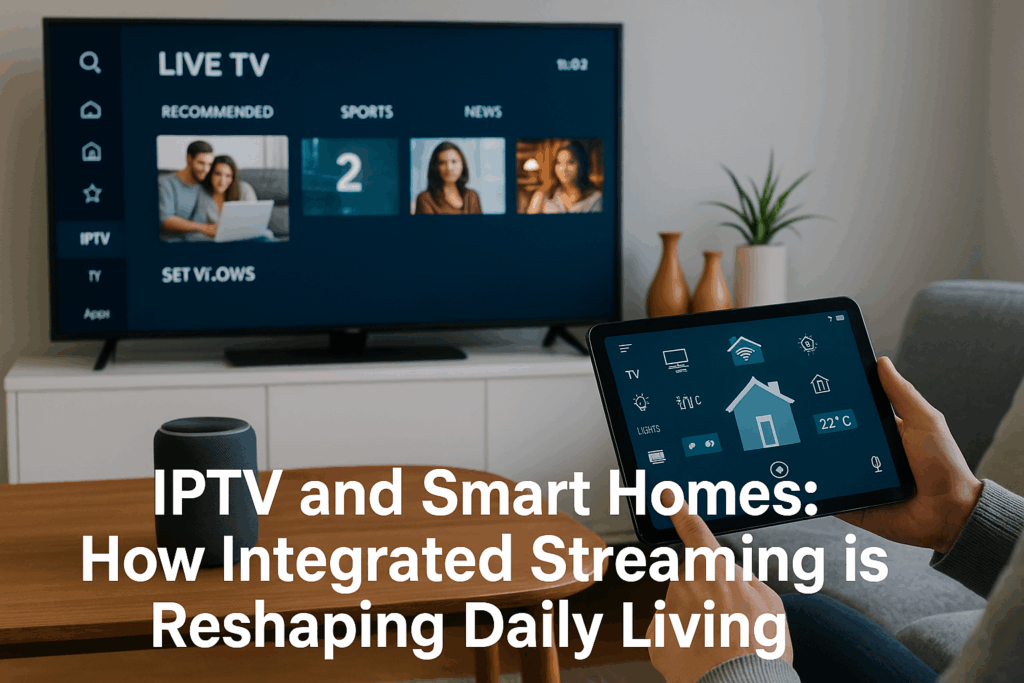
In 2025, the digital revolution has moved beyond smartphones and laptops into the very fabric of our homes. Smart homes are no longer just a futuristic concept—they’re a daily reality for millions. And at the core of this connected lifestyle lies IPTV (Internet Protocol Television). This article explores how IPTV and smart home systems are merging to redefine entertainment, convenience, and everyday living.
1. What is IPTV in a Smart Home Context?
IPTV delivers television content over the internet instead of traditional cable or satellite. But when integrated into smart homes, IPTV evolves beyond streaming—it becomes a dynamic part of your automated ecosystem.
Imagine walking into your home and your smart assistant says, “Welcome back. Shall I resume your documentary?” Your IPTV system, synchronized with lighting, sound, and voice control, continues exactly where you left off. This is more than just convenience; it’s a personalized, immersive experience.
2. Voice-Activated Control: “Alexa, Play My Series”
Voice assistants like Amazon Alexa, Google Assistant, or Apple’s Siri are becoming IPTV’s best friends. You can now control your entire viewing experience with simple voice commands:
- “Play the latest episode of Stranger Things.”
- “Switch to sports channel.”
- “Record tonight’s news at 8 PM.”
No remote. No searching. Just seamless control that adapts to your habits and preferences.
3. Room-Based Customization
One of the standout features of IPTV in a smart home is multi-room personalization. Each room in your house can offer a different viewing experience:
- Living Room: High-definition streaming with ambient lighting for movie nights.
- Kitchen: News briefs or cooking shows displayed on a smart fridge screen.
- Bedroom: Calm nature channels or sleep-friendly music streamed at a low volume.
Thanks to synchronized systems, your IPTV adapts based on room, time, or even your mood.
4. Smart Energy Consumption
Traditional TVs and cable boxes often consume power even when not in use. IPTV integrated with smart energy systems can help reduce this waste. For example:
- Automatically powering down when no one is home.
- Adjusting screen brightness based on time of day.
- Sending notifications if a device is running unnecessarily.
Over time, this not only saves energy but also reduces costs.
5. Security Integration
Yes, IPTV can even play a role in home security. Many IPTV platforms now allow real-time streaming of CCTV or video doorbells:
- Watch who’s at your door directly from your TV.
- Get pop-up alerts if motion is detected near your property.
- Integrate baby monitors and interior cameras for family safety.
Entertainment and protection—together in one unified interface.
6. IPTV for the Elderly and Disabled
Smart IPTV systems can be a game-changer for people with limited mobility. Voice-controlled navigation, larger text interfaces, and personalized channels make it easier for elderly users to access entertainment and stay connected.
In addition, home assistants can combine IPTV with reminders for medications, video calls with family, or emergency alerts.
7. AI-Powered Recommendations That Learn You
Forget generic suggestions. With AI integrated into smart IPTV systems, your preferences are analyzed across platforms:
- What time you usually watch.
- Your most watched genres.
- Mood-based predictions using wearable data (e.g., fitness trackers).
The result? A hyper-personalized content feed that evolves as your lifestyle changes.
8. Cross-Device Continuity
Start watching a movie on your living room TV, continue it on your tablet while cooking, and finish it in bed. IPTV in smart homes enables seamless content transfer across devices. Everything is in sync thanks to the cloud.
No more rewinding. No more searching. Just pick up where you left off.
9. Automated Routines for Peak Relaxation
You can program routines such as:
- “Movie Mode” — dims lights, closes blinds, turns on the home theater, and launches Netflix.
- “Good Morning” — plays the news while your smart coffee machine starts brewing.
These routines make IPTV part of your daily lifestyle, not just a separate entertainment tool.
10. Why This Trend Matters in 2025
The global smart home market is expected to surpass $170 billion in 2025. IPTV is no longer an isolated service—it’s a central piece of the connected lifestyle puzzle. Consumers want systems that are intuitive, personalized, and energy-efficient. IPTV delivers all of that, especially when integrated intelligently with other devices.
Conclusion
IPTV has evolved far beyond just streaming television. In a smart home, it becomes an intelligent companion—automated, voice-controlled, secure, and tailored to your life. As more households upgrade to smarter ecosystems, IPTV stands out not just as a convenience but as a cornerstone of modern living.
The future of television isn’t just about what you watch. It’s how, when, and where you watch it—and IPTV in smart homes is delivering that future today.
